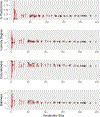Degree and not type of iconicity affects sign language vocabulary acquisition
- PMID: 31094562
- PMCID: PMC6858483
- DOI: 10.1037/xlm0000713
Degree and not type of iconicity affects sign language vocabulary acquisition
Abstract
Lexical iconicity-signs or words that resemble their meaning-is overrepresented in children's early vocabularies. Embodied theories of language acquisition predict that symbols are more learnable when they are grounded in a child's firsthand experiences. As such, pantomimic iconic signs, which use the signer's body to represent a body, might be more readily learned than other types of iconic signs. Alternatively, the structure mapping theory of iconicity predicts that learners are sensitive to the amount of overlap between form and meaning. In this exploratory study of early vocabulary development in American Sign Language (ASL), we asked whether type of iconicity predicts sign acquisition above and beyond degree of iconicity. We also controlled for concreteness and relevance to babies, two possible confounding factors. Highly concrete referents and concepts that are germane to babies may be amenable to iconic mappings. We reanalyzed a previously published set of ASL Communicative Development Inventory (CDI) reports from 58 deaf children learning ASL from their deaf parents (Anderson & Reilly, 2002). Pantomimic signs were more iconic than other types of iconic signs (perceptual, both pantomimic and perceptual, or arbitrary), but type of iconicity had no effect on acquisition. Children may not make use of the special status of pantomimic elements of signs. Their vocabularies are, however, shaped by degree of iconicity, which aligns with a structure mapping theory of iconicity, though other explanations are also compatible (e.g., iconicity in child-directed signing). Previously demonstrated effects of type of iconicity may be an artifact of the increased degree of iconicity among pantomimic signs. (PsycINFO Database Record (c) 2019 APA, all rights reserved).
Figures






References
-
- Anderson D, & Reilly J (2002). The MacArthur communicative development inventory: Normative data for American Sign Language. Journal of Deaf Studies and Deaf Education, 7(2), 83–106. - PubMed
-
- Andrews M, Vigliocco G, & Vinson D (2009). Integrating experiential and distributional data to learn semantic representations. Psychological Review, 116(3), 463. - PubMed
-
- Barsalou LW (1999). Perceptions of perceptual symbols. Behavioral and brain sciences, 22(4), 637–660. - PubMed
-
- Bates D, Maechler M, Bolker B, Walker S, Christensen RHB, Singmann H, … & Grothendieck G (2014). Package ‘lme4’. R foundation for statistical computing Vienna, 12.
MeSH terms
Grants and funding
LinkOut - more resources
Full Text Sources
Medical
Research Materials

